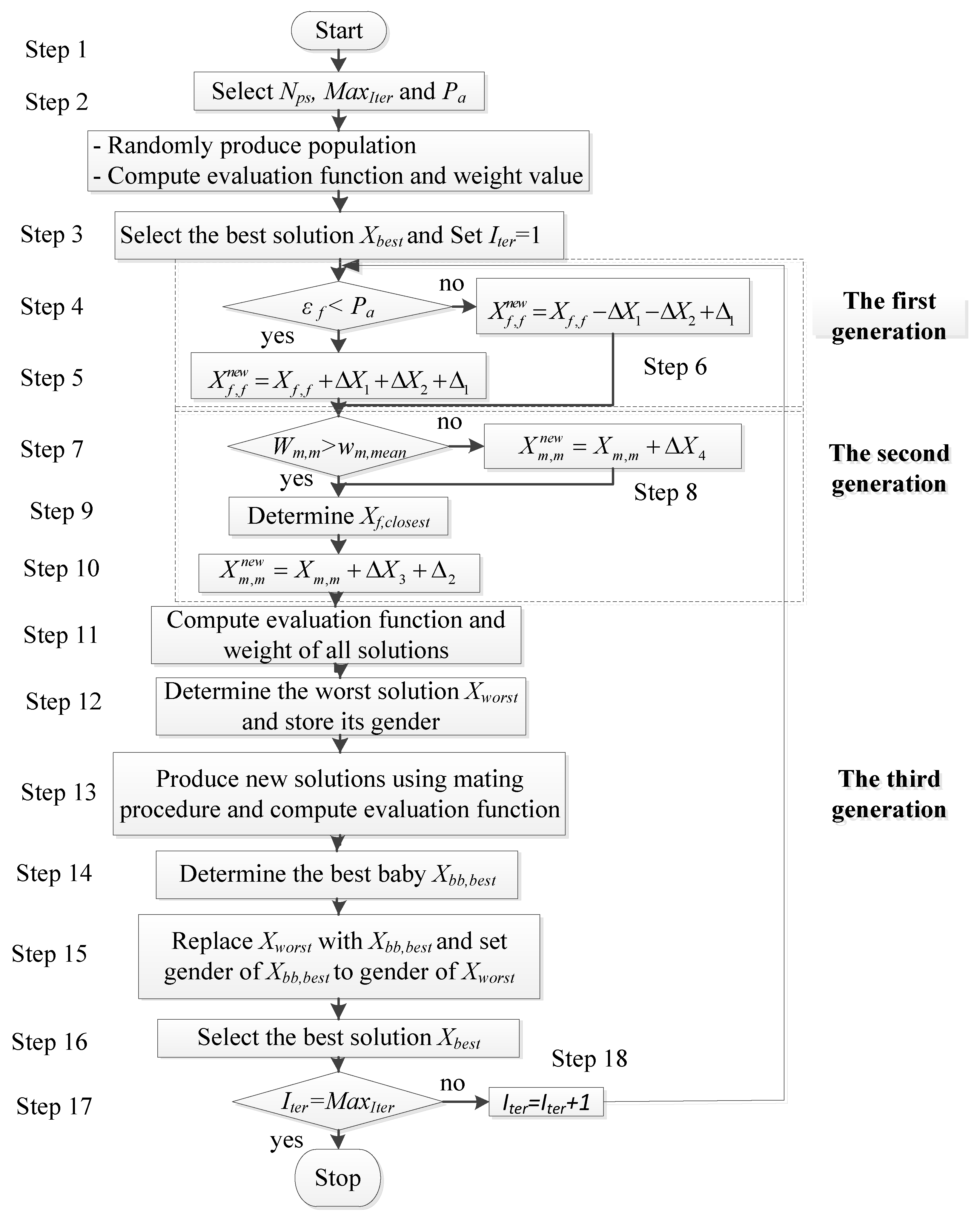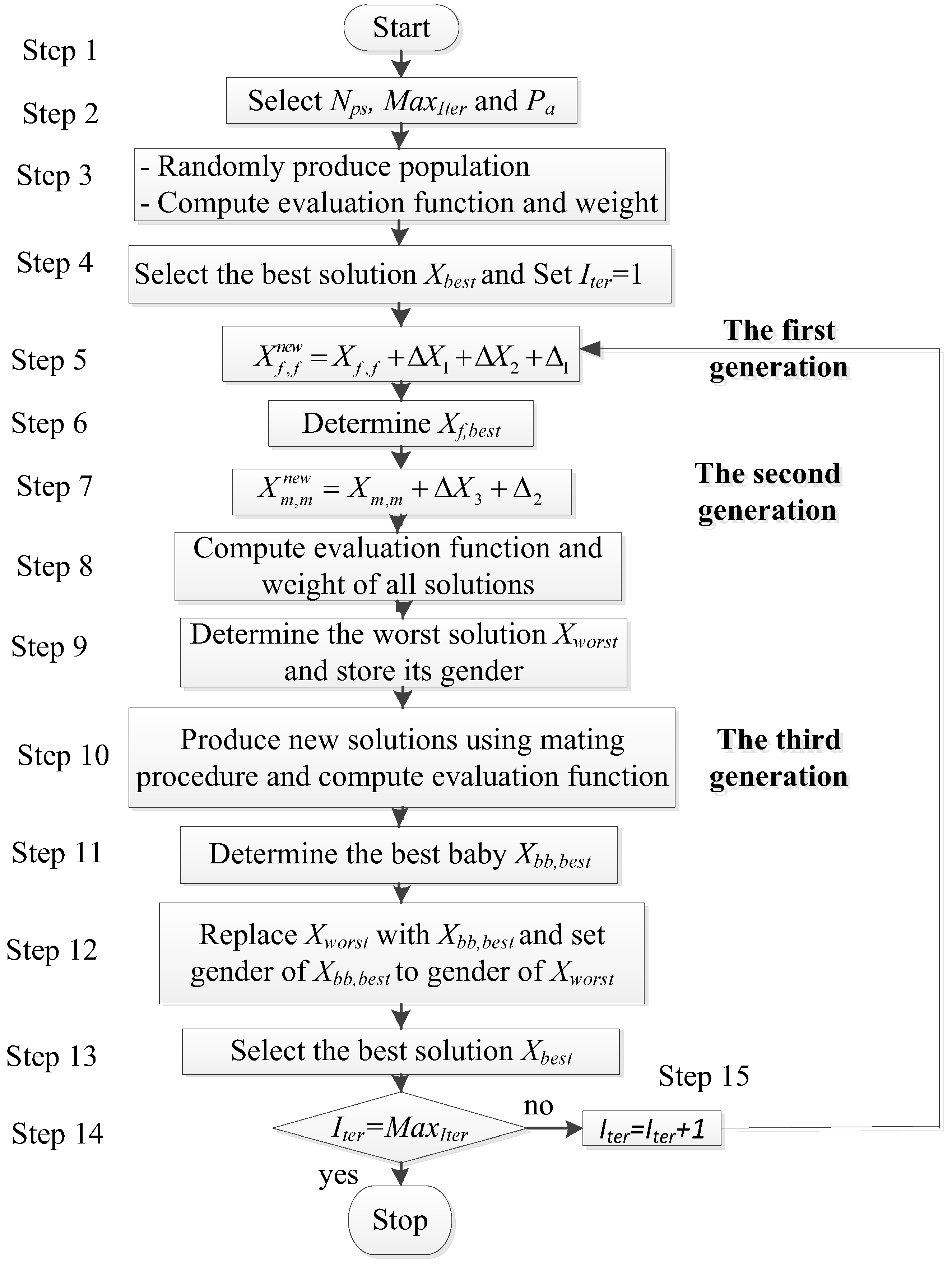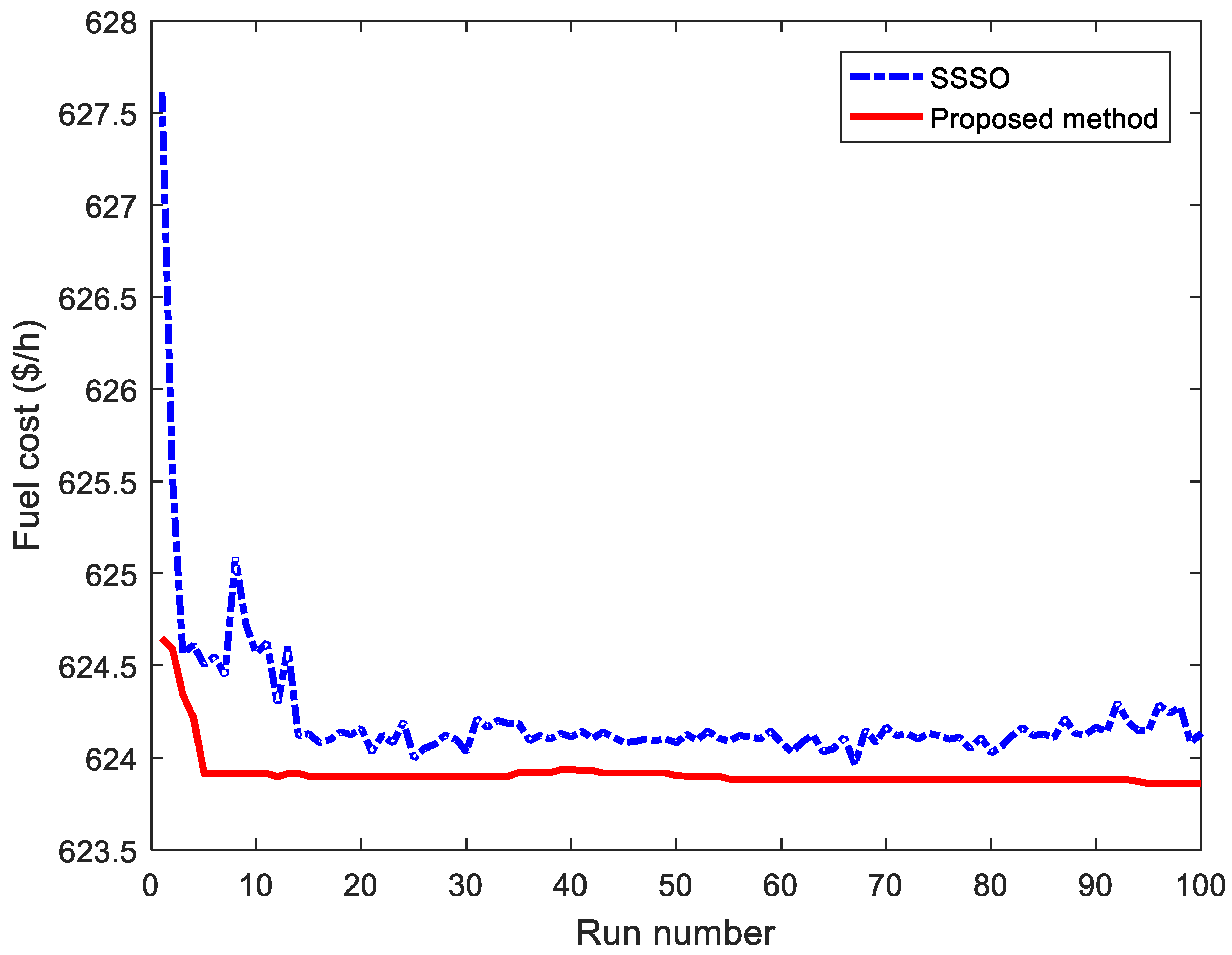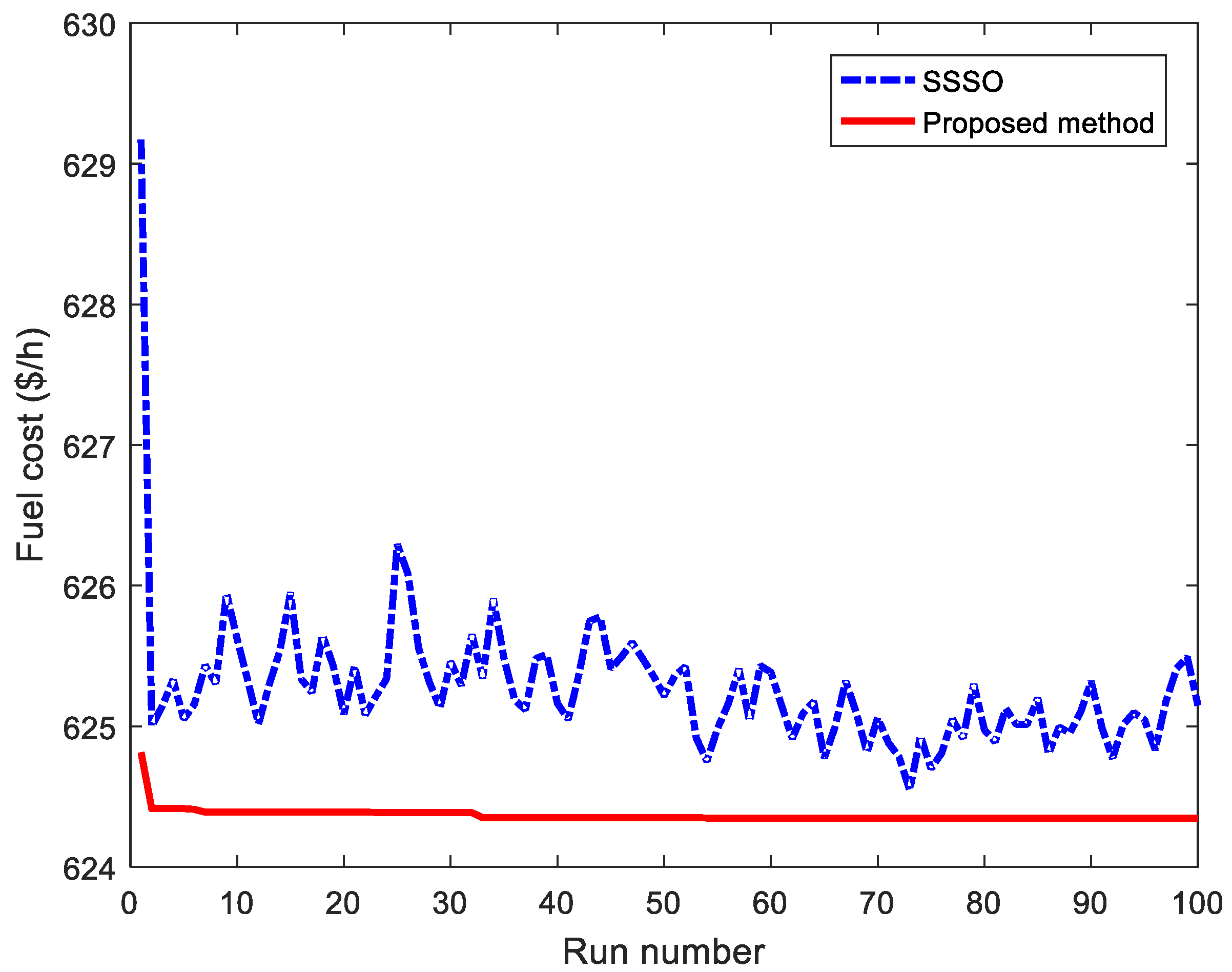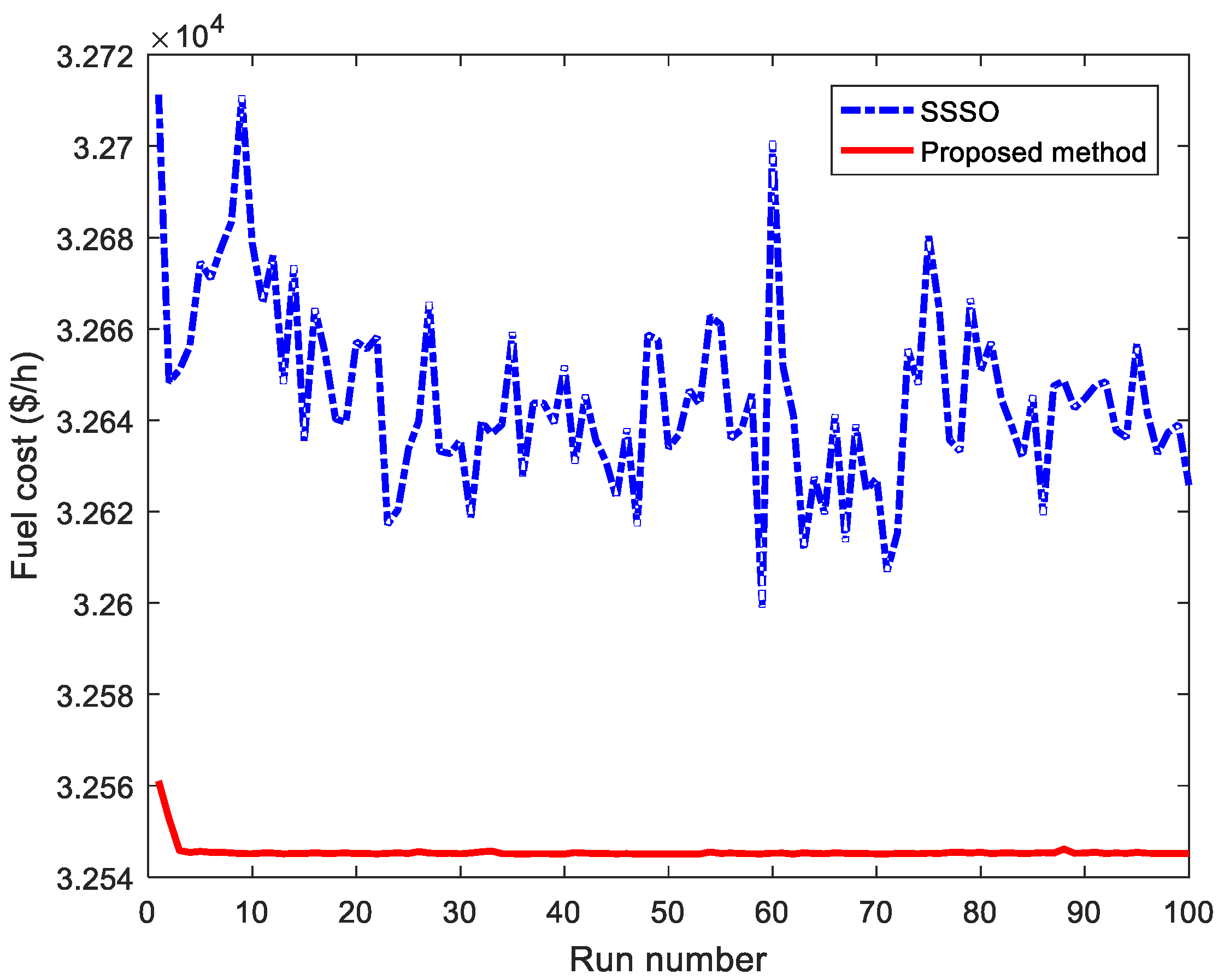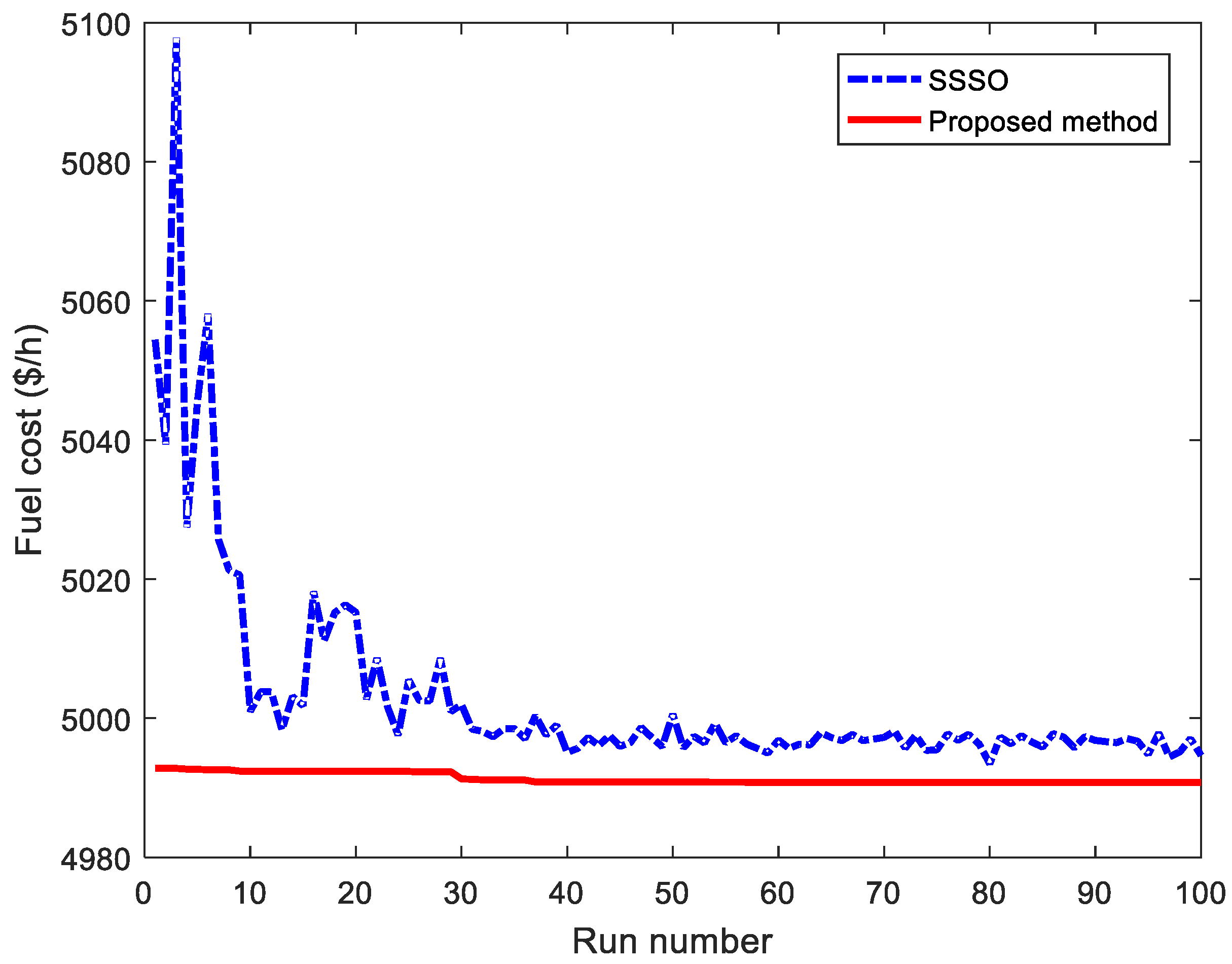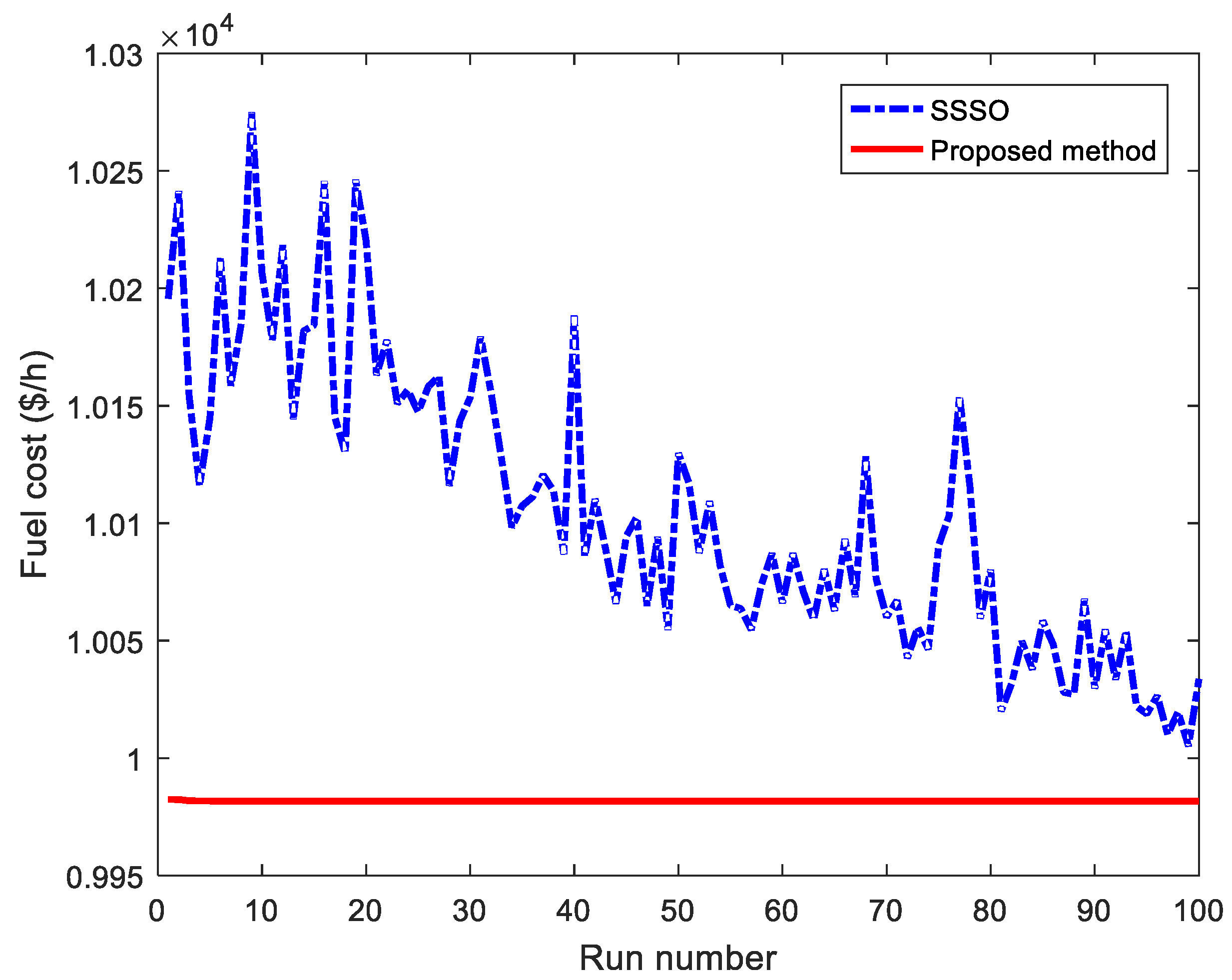1. Introduction
Economic load dispatch (ELD) is one of the most complex problems in power system optimization operation consisting of the specific objective of reducing total electric generation fossil fuel cost and taking constraints regarding all power plants into account. The problem tends to take different power plants into account such as thermal power plants, hydropower plants and renewable power plants such as wind turbines, solar thermal power plant and photovoltaic cells. In this paper, we consider thermal power plants as researched objects in which different characteristics of objective functions and different constraints of thermal power plants are taken into account. Consequently, the considered problem here is mathematically formulated by the presence of objectives and constraints where the objective is the power output-fossil fuel cost function-based characteristic while constraints consider the stable operating conditions of thermal power plants.
Over the last decades, a huge number of researchers found optimal operation parameters of interconnected thermal power plants or all thermal generating units in each thermal power plant by employing optimization algorithms based on optimization theory or natural phenomena. Basically, these applied methods are classified into two large groups in which the first large group is based on derivatives and neural networks while the second large group is based on heuristic searches. Methods in the first group are the Lagrange optimization function and iterative algorithm-based methods (LR-IAM) [
1,
2], Hopfield modelling framework (HMF) [
3], linear programming techniques (LPT) [
4], hierarchical algorithm (HA) [
5], Hopfield neural network (HNN) [
6], improved Hopfield neural network (IHNN) [
7], augmented Lagrangian Hopfield network (ALHN) [
8,
9,
10]. Although the number of methods in the first group is significant, those in the second group are much more, such as differential evolution (DE) [
11], colonial competitive differential evolution (CCDE) [
12], hybrid differential evolution with biogeography-based optimization (HDE-BBO) [
13], cuckoo search algorithm (CSA) [
14], one rank cuckoo search algorithm (ORCSA) [
15], Local random search technique-based modified particle swarm optimization (LRS-MPSO) [
16], self-updated parameter technique-based PSO (SUP-PSO) [
17], PSO with self-adaptively updated parameters (NAPSO) [
18,
19], iteration particle swarm optimization (IPSO) [
20], iteration PSO with time varying acceleration coefficients (IPSO-TVAC) [
21], species-based quantum particle swarm optimization (SQ-PSO) [
22], krill herd algorithm (KHA) [
23], Opposition-based krill herd algorithm (OKHA) [
24], teaching technique and learning technique-based algorithm (TLA) [
25,
26], genetic algorithm with updated multiplier (UM-GA) and modified genetic algorithm with updated multiplier (UM-MGA) [
27], modified real-coded genetic algorithm (MRCGA) [
28], firefly algorithm (FA) [
29], modified firefly algorithm (MFA) [
30], improved firefly algorithm (IFA) [
31], artificial immune system (AIS) [
32], bacterial foraging algorithm (BFA) [
33], multiple tabu search (MTS) [
34], harmony search (HS) [
35], natural updated harmony search harmony search (NUHS) [
36], chaotic bat algorithm (CBA) [
37], improved quantum-inspired evolutionary algorithm (IQEA) [
38], exchange market algorithm (EMA) [
39], biogeography-based optimization (BBO) [
40], flower pollination algorithm (FPA) [
41], competitive swarm optimizer (CSO) [
42], Franklin law and Coulomb law-based algorithm (FCA) [
43], symbiotic organisms search (SOS) [
44], improved symbiotic organisms search algorithm (ISOS) [
44], and oppositional real coded chemical reaction optimization (ORCCRO) [
45].
Basically, applications of methods in the first group for complex ELD problem are being discontinued due to the huge number of restrictions such as dependence on the characteristics of considered systems, high oscillation for large-scale systems and incapability of solving non-differentiable functions. The best achievement of the first group has been obtained when applying ALHN, which could tackle several of the mentioned drawbacks but the main issue that still exists is that it is incapable of solving non-differentiable functions. Thus, there have not been any developments in this group in recent years. Instead, applications of heuristic algorithms for such complex ELD problem have constantly been developed so far. Ancient original heuristic methods, such as PSO, GA and DE, have been improved effectively by adding changes in solution generation formulas or in selection technique. DE is comprised of mutation, crossover and selection techniques, and its main disadvantage is to easily fall into local optimum due to low effectiveness of mutation technique. Thus, CCDE and HDE-BBO have focused on enhancing mutation technique for finding promising candidate solutions. HDE-BBO has proposed hybrid migration operator for selecting different models for mutation technique while other techniques of DE have remained unchanged and been used in HDE-BBO method. CCDE has been developed by using different suggested mutation techniques relied on mathematical modelling of socio-political evolution in aim to diversify search strategies and exploit local search effectively. The method has suggested a huge number of mutation formulas and different values of control parameter have been tuned for the best solutions of different systems. Found solutions could lead to a conclusion that mutation change was the most suitable selection. CSA is a widely and successfully applied method for ELD problem due to its exploitation and exploration corresponding to local search and global search abilities. The method has two generations in each iteration and there must be two selections in each iteration. The feature seems to take more time for CSA to seek solutions for per iteration but it gets results incredibly effectively and fast. In fact, CSA has seen its strong points via a huge number of test cases in [
14]. Although CSA could achieve promising numerical results better than those from other existing methods, it could be improved better in connection with solution quality and search speed. ORCSA was built for shortening search time and reducing search steps that were being used in CSA as said above such as two generations and two selections in each iteration. Most modifications of PSO are to change formula calculating velocity but still keep formula determining position of each particle. NAPSO [
18,
19] has proposed new formula calculating velocity and tuned inertia weight by using fuzzy rules. In addition, other parameters have been set to self-adaptation. The method was run accompany with conventional PSO and PSO with fuzzy mechanism (FPSO) to prove its outstanding performance. LRS-MPSO [
16] has added one more local search technique and memorized the worst position of each particle. The two modifications have intentionally enhanced exploitation and exploration abilities. In [
16], LRS-MPSO has been compared with GA, PSO, modified PSO (MPSO) and PSO with local random search (LRS-PSO). Result comparisons have indicated LRS-MPSO could improve results effectively for some tests, but for some cases, the method could not find better optimal solutions. SUP-PSO [
17] has used improved constriction factor and self-adaptive acceleration coefficients together with change of formula calculating velocity. Thus, the method was highly superior to PSO for solutions of ELD problem. IPSO in [
20] was a strange version of PSO since the current position subtracted from the best fitness function value was additional step size. Furthermore, the study also proposed a new formula calculating maximum velocity, which was totally different from all other versions of PSO. The two modifications could enrich capability of jumping out local optimal zones and reaching global optimal zones. Thus, the method was much better than PSO. IPSO-TVAC [
21] has used IPSO in [
20] and adaptive acceleration coefficients in order to highly enrich global seeking ability of PSO. As a result, IPSO-TVAC was more effective than IPSO in [
20] and PSO. SQ-PSO, a newly updated version of quantum PSO (QPSO), has classified solutions into different groups relied on solutions’ quality and radius. Different strategies have been applied for producing new solutions for each considered solution based on evaluation of quality and such radius. The method has seen its improvement over QPSO and PSO via several test systems. KHA has been used in [
23] while the integration of KHA and opposition-based learning method (KHA-OL) has been developed in [
24] for solutions of ELD problem. MRCGA, an improved version of RCGA, has used arithmetic average bound crossover technique and wavelet mutation technique, which are completely different from those of RCGA. Advantages of the method have been also demonstrated better than UM-GA and UM-MGA as well as other versions of GA. MFA and IFA are two improved versions of FA wherein such two versions have had the same modifications of changing radius calculation formula and changing formula calculating mutation technique. MFA has used an adaptive parameter with respect to iteration while IFA has proposed different models for seeking new solutions. Both MFA and IFA have found better results than FA but their performance was still modest when compared to other methods. For other remaining methods, most of them are original techniques seeking solutions of ELD problem excepting ISOS [
44], which is a modified version of SOS. ISOS has used two different models, which were taken from CCDE, for replacing ancient mutation technique of SOS. Such changes could bring advantages to ISOS over SOS such as reduction of computation steps and simulation time.
In general, authors have tended to apply original optimization tools or analyse these methods’ disadvantages and then they have proposed their improved methods in aim to find solution of ELD problem so that total electric generation fossil fuel cost could be lower than that from other existing methods. Similarly, in the paper we propose an effective social spider optimization algorithm, which is newly constructed from standard social spider optimization (SSSO) [
46]. Similar to other methods, SSSO has been also tested on benchmark functions and its solutions have been competed to those of artificial bee colony (ABC) and PSO. Then, such method was newly developed and formed different modified SSO (MSSO) methods presented in [
47,
48,
49]. MSSO in [
47] has applied new strategy of predetermining the most effective solution. In the method, the best solution was continuously updated as soon as one new solution was produced and it was substituted into new candidate solution creation formula after it was identified. The proposed idea could move search space continuously and enrich exploration ability of SSSO but it also coped with other unintentionally weak points such as using higher number of computation steps and taking more simulation time than SSSO. MSSO in [
48] has applied diversified mutation techniques similar to CCDE for seeking candidate solutions. Such modified method could intensify capability of seeking dominated solutions for SSSO but proposed ideas here also formed a MSSO method completely different from SSSO method. Unlike methods in [
47,
48], authors in [
49] have developed four different modified SSSO (MSSO) methods by combining different modifications from PSO variants such as adding adaptive inertia weight and constriction factor, adding one more updated step size to new solutions. Their suggested ideas could enhance search ability of SSSO but it also caused more control parameters needing more selections and longer simulation time. Clearly, review on improved versions of SSSO can see that most methods have advantages as well as disadvantages, so in the paper we make a big effort introducing a new improved SSSO method so that the disadvantages of the mentioned MSSO methods above do not exist. In our ISSO method, we aim to reduce the computation steps, use of the most effective formulas, shortening simulation time and especially reduction of control parameter. For the target, we keep only one formula among two available equations of SSSO for the first and the second new solution creations. Then, we suggest changing such two retained equations so that they could create promising solutions. The proposed method’s superiorities can be investigated by testing on six systems with 6, 10, 15, 80, 160 and 320 units. In addition, different input-output characteristics and different constraints of thermal units and power systems are also considered. Results from the proposed method are compared to those from SSSO and other mentioned methods above. As a result, the main contributions of this paper are summarized as follows:
- (1)
Simplify solution search procedure of SSSO.
- (2)
Abandon less effective formulas producing low quality solutions and keep outstanding formulas.
- (3)
Cancel some computation steps of SSSO.
- (4)
Cancel one control parameter and quit tuning values of such parameter.
- (5)
Find better solutions and use small number of iterations.
The organization of the remainder of the paper is as follows: in
Section 2, we deal with the economic load dispatch problem formulation.
Section 3 presents the main contents involving the development of the proposed method. The applications of the proposed method for the economic load dispatch problem have been stated in
Section 4.
Section 5 and the
Appendix A present the study cases and numerical simulation results. Finally, the conclusions are given in
Section 6.
